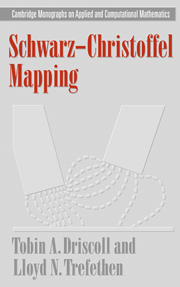Preface
Published online by Cambridge University Press: 20 August 2009
Summary
In the autumn of 1978, Peter Henrici took leave from the ETH in Zurich to visit the Numerical Analysis Group at Stanford University. The second author, then a graduate student, asked Henrici if he might propose a project in the area of computational complex analysis. Henrici's suggestion was, why don't you see what you can do with the Schwarz–Christoffel transformation?
For months thereafter LNT spent all of every weekend working on SC mapping at the computer terminals of the Stanford Linear Accelerator Center. This brief but intense project led to one of the first technical reports ever printed in TEX, which was published in the first issue of the SIAM Journal on Scientific and Statistical Computing; to the FORTRAN package SCPACK; and to a lasting love of numerical conformal mapping. In the following years it led further to extensions and applications of SC ideas carried out in collaboration with various people, including Alan Elcrat and Frédéric Dias on free-streamline flows, Ruth Williams on oblique derivative problems, and Louis Howell on modified formulas for elongated regions.
By the early 1990s, LNT was a faculty member at Cornell University and the first author was a graduate student. We worked together on a number of topics from hydrodynamic stability to “Can one hear the shape of a drum?” but the subject we kept coming back to was Schwarz–Christoffel mapping. Once again it started with a brief suggestion.
- Type
- Chapter
- Information
- Schwarz-Christoffel Mapping , pp. xv - xviPublisher: Cambridge University PressPrint publication year: 2002

